Visiting Kew Gardens in Winter is one of the great outdoor adventures in London
After saying hello to the Swan, we look at the world of Holly, and find out there is more to this than meets the eye in the wintery backdrop of London’s most famous garden.
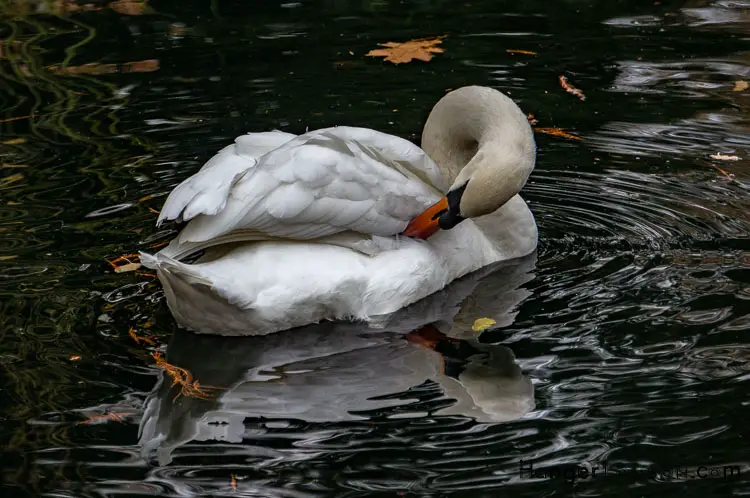
Kew Gardens’ impressively large collection of Holly
Here you will find one of the largest collections in the world of different varieties of Holly. Hundred-year-old Holly exists at Kew, lasting up to 300 years. Beautiful shapes and colours, yellow, greens spiked not spiked, two-toned, rounded ovals, with berries, without berries trailing, shiny matt. They originally called Holly Walk, Love Lane, which separated Richmond Garden from Kew Gardens. It formed part of a public walkway that enabled people to go from Kew to Richmond. Lying South of Kew Gardens it ends at the towards the direction of the Japanese Pagoda and Cedar Vista area, and Treetops Walkway and the Temperate House.
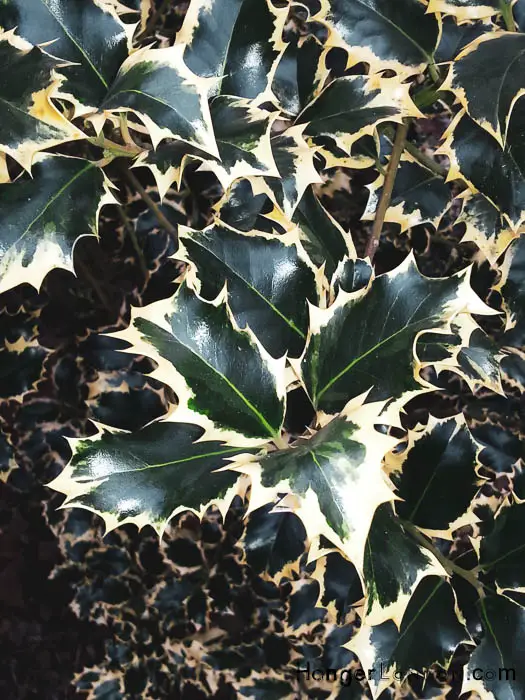
Holly falls under the classification of the Aquifoliaceae family. The Latin name Ilex aquifolium. It can be Evergreen or deciduous. It can grow into trees, shrubs it can trail or climb known a term known as Liana.
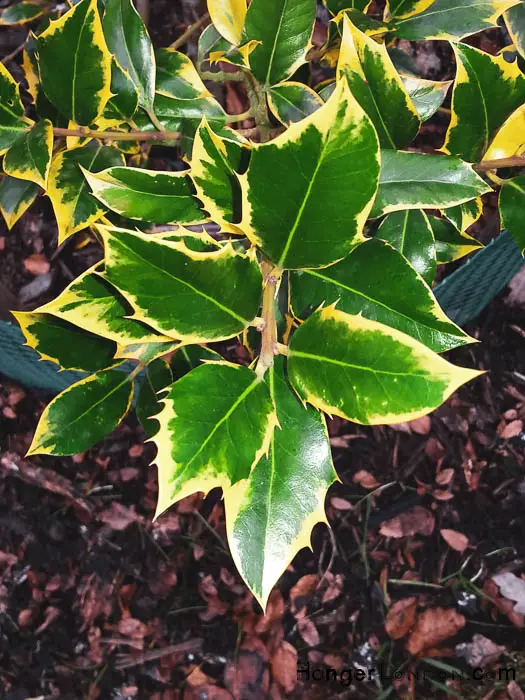
Its name comes from the Old English word holegn meaning “To prick”. It is also a name often given to baby girls born at Christmas. Audrey Hepburn’s iconic character in Breakfast At Tiffany’s was Holly Golightly.
Walking Sticks made of Holly hardwoods
The wood that comes from holly is a hardwood with a fine grain, that is hard to see. Good firewood is much whiter than other woods. Made into walking sticks, furniture, weather & Mathematical instruments, whips, veneering, and handles for teapots mimicking Ebony, were often black stained holly wood. It could produce a dye for fabrics from the leaves.
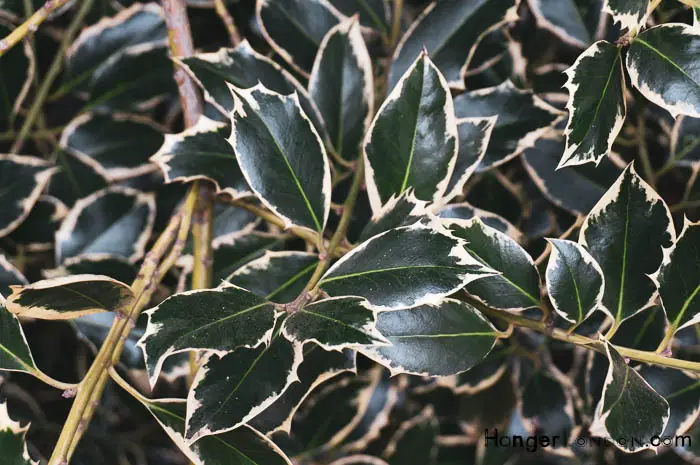
There is a Holly Remedy in the Bach Flower range, associated with inner harmony or for the states of mind when there is an absence of Love.
Generations past gave the leaves to animals as the food was less available in winter. The tops of Holly trees, and bushes are not spikey as the base leaves, which is all part of its inbuilt protection system. Useful as an insecticide because of its bitter tannins.
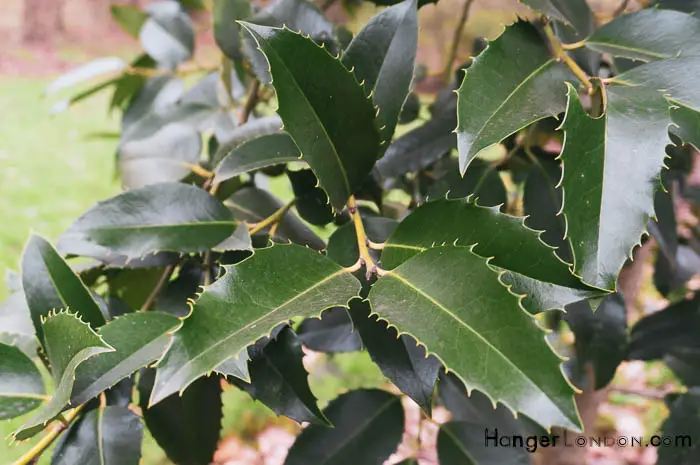
Red Berries are plenty in the Garden
These are poisonous to humans but a source of food for birds and small woodland animals in winter. The Plant is dioecious, meaning it has separate male and female plants. They need two separate plants to produce the berries.
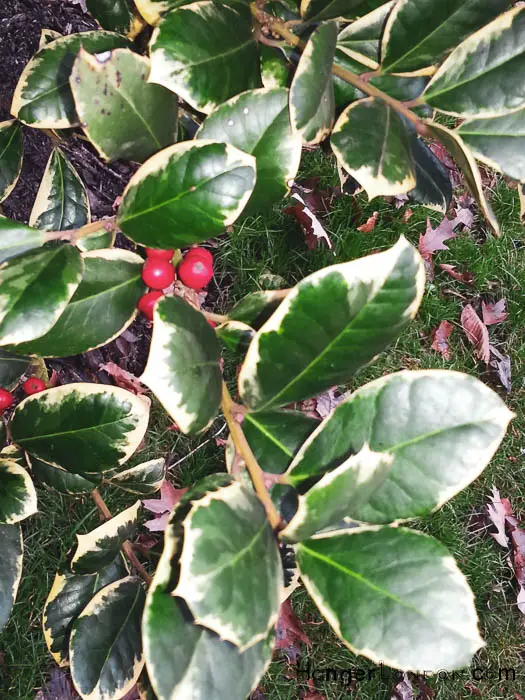
What is the Symbolism of Holly at Christmas?
During Christmas, seen in wreaths, decorations, illustrations on Christmas cards, wrapping paper, and the finishing touch to the top of a British Christmas pudding. Even Carols such as the Holy and the Ivy mention it. Before the 1800s they used it as a Christmas tree
They used Holly in protecting people’s homes to ward off evil spirits witches, and goblins. The Romans around the Winter Solstice celebrate the Saturn god and they thought holly to protect them from harm and lightning.
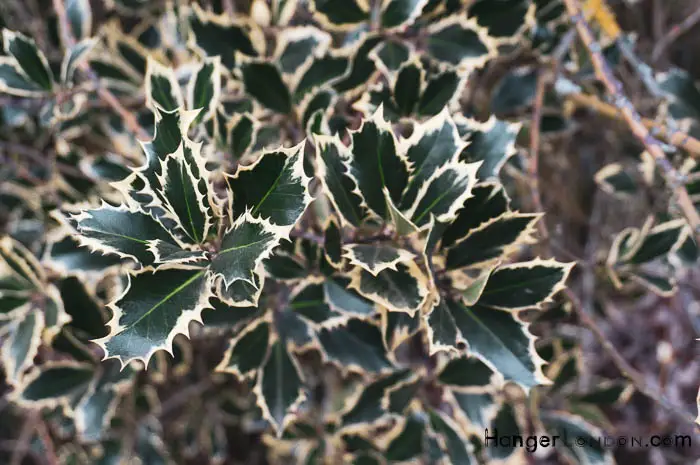
Holy and Religion, what is the link?
Many Christians see holy and its red berries as symbolic of Christ’s Thorny crown and blood during the crucifixion, often called “Christ’s Thorn”.
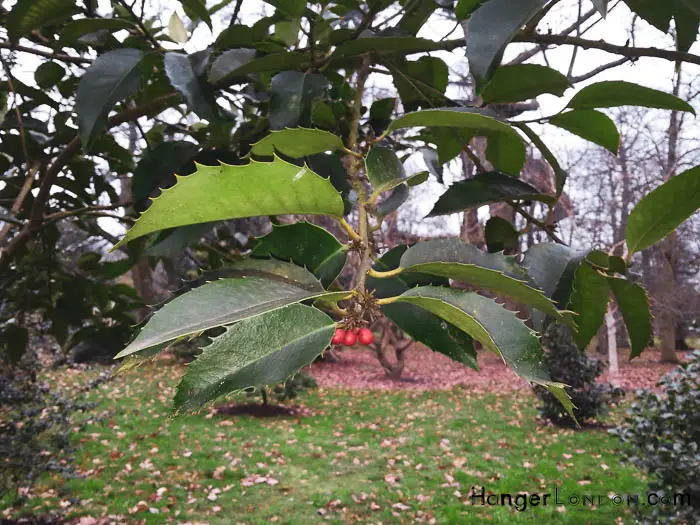
Pagan, Celtic anglo Saxon seasonal festivals and customs also feature a holly-dressed god/Man celebrating the start of Epiphany which is around the 5th/ 6th of January, and a celebration of the baptism of Christ and nativity.
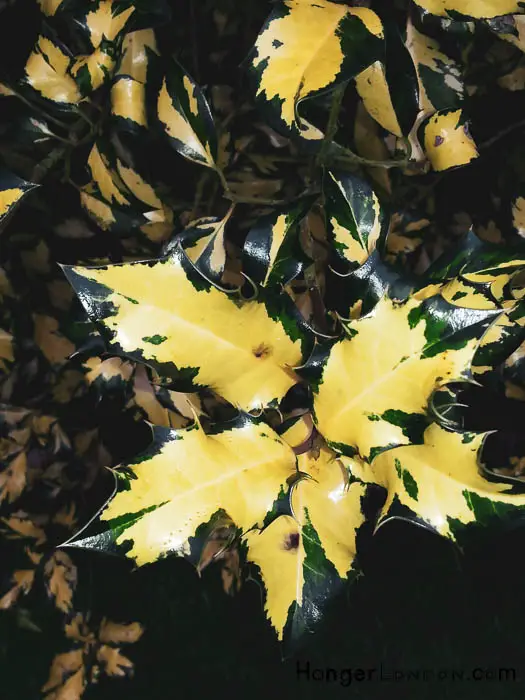
The Holly Man symbolises good growth for the plants during the new seasons to come after winter.
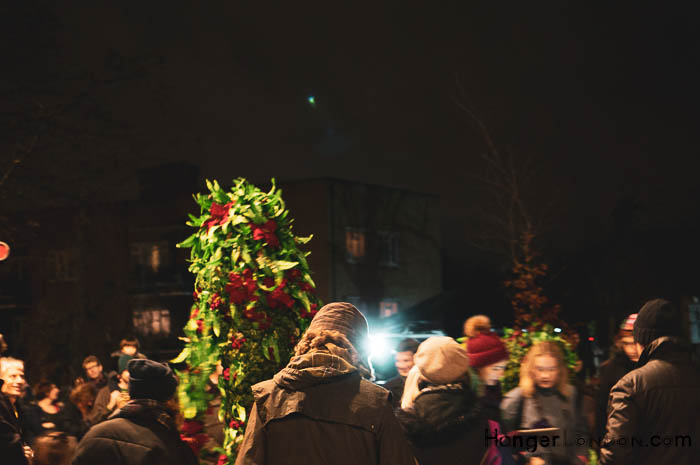
Epiphany is around the 12th night when people take their Christmas decorations down.
The twelfth night is the last day of the 12 days of Christmas Day one for many is Christmas day the 25th of December although some start it from Boxing Day. In Ireland, 3 wise men feature in the nativity crib on the 12th night, many churches have their manger nativity still up around the 12th night.

Possibly Chinese Holly Illex Cornuta
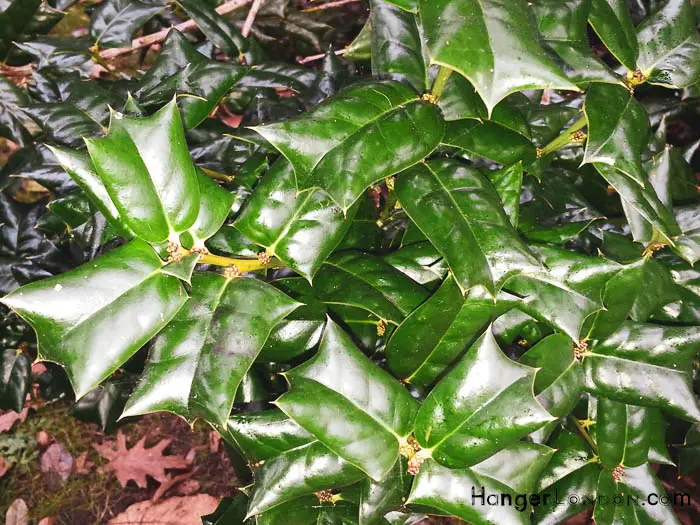
Chinese Holly (Illex Cornuta) is a versatile evergreen shrub that can be found in a variety of landscapes and gardens. With its glossy green leaves, spiny edges, and red berries, it adds a splash of color and texture to any setting. It’s also a great option for hedges or screens due to its dense growth habit. The plant prefers well-drained soil and full sun to partial shade and is relatively low maintenance. In winter, the leaves may take on a bronze or purple hue, providing interest and variety throughout the year. Whether used in a formal garden setting or in a more natural landscape, Chinese Holly is a reliable and attractive choice.
Anyone know what type of Holly this is? Comment below
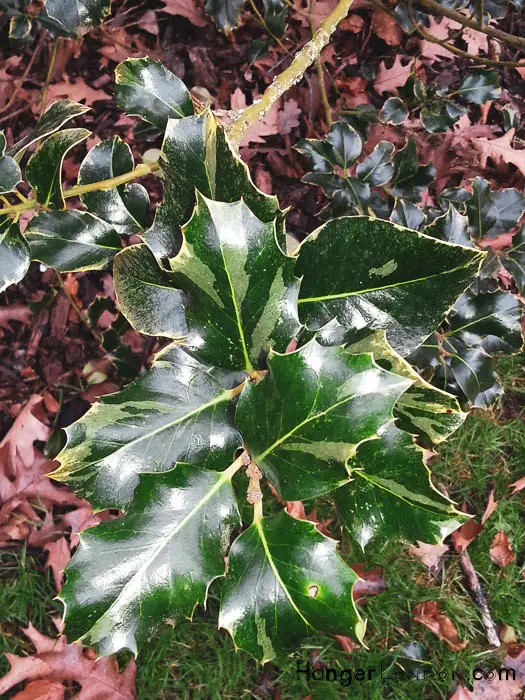
Two legendary British Diarists liked Holly
Sayes Court Deptford, Home of John Evelyn, diarist, horticulturist, and one of the founder members of the Royal Society had a prized large holy hedge. In 1665 Pepys commented that the Holly Hedge was one of the “finest things I ever saw in my life.” Evelyn’s book Sylva on Tree Cultivation created interest and change.
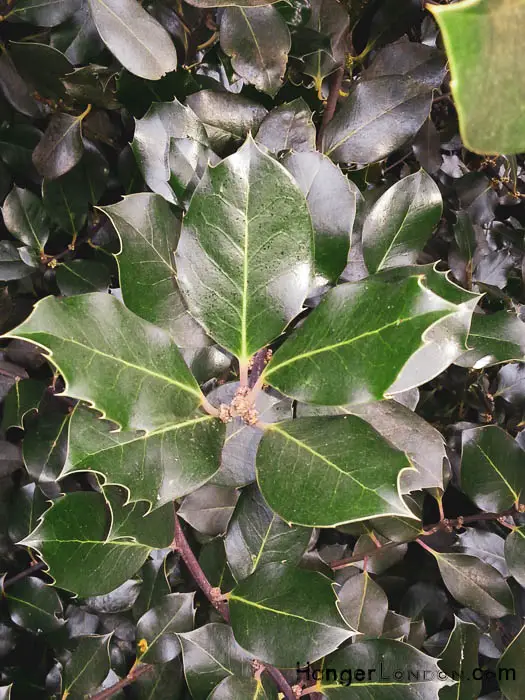
Here is a list of the view of the holly species we saw at Kew and some photos.
Ilex aquifolium, also known as English Holly
Ilex aquifolium, commonly known as English Holly, is an evergreen tree native to western and southern Europe, northwest Africa, and southwest Asia. It is a popular garden plant, known for its glossy green leaves, attractive red berries, and spiny foliage. The leaves are usually dark green and glossy, with a smooth edge and pointed tips. The berries are small and bright red and appear in the autumn and winter months. In the UK, holly is often associated with Christmas, as it is a popular decoration during the festive season.
Holly is a slow-growing tree that can grow up to 15 meters tall, but it is often used as a hedge or screen and can be easily shaped and pruned to fit a particular space. It prefers well-drained soil and can tolerate both sun and shade, making it a versatile addition to any garden. It is also an important food source for birds, who eat berries during the winter months when other food sources are scarce. Holly has also been used in traditional medicine, with the leaves and berries being used to treat a range of ailments including fever, coughs, and rheumatism.
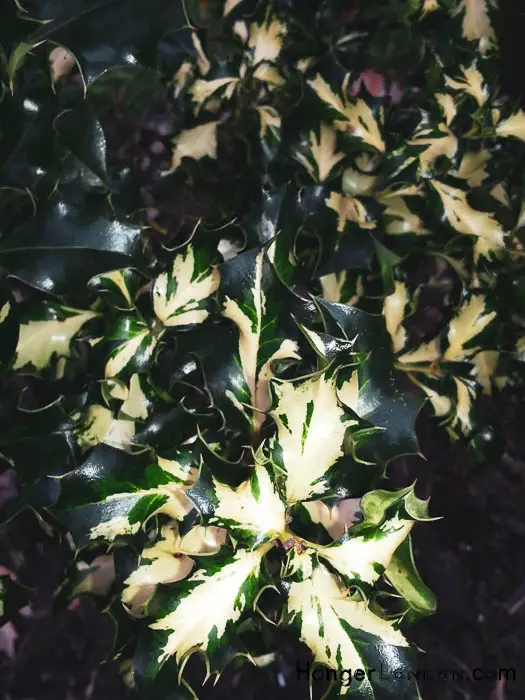
Ilex X altaclerensis “Elegantissima”
Ilex x altaclerensis ‘Elegantissima’ is a striking, evergreen shrub that makes a great addition to any garden. This hybrid holly is a cross between Ilex aquifolium and Ilex perado and is known for its stunning foliage. The leaves are a glossy dark green with creamy-white margins that add a touch of elegance and contrast to the plant. In the winter months, the leaves take on a pinkish-red tint, adding even more interest to the shrub.
‘Elegantissima’ is a slow-growing shrub that can reach up to 6 feet in height and spread to around 4 feet wide. It has a dense, bushy habit that makes it ideal for hedging or as a specimen plant. It thrives in a wide range of conditions and is tolerant of most soils, as long as they are well-drained. It also prefers partial shade to full sun, and is relatively low-maintenance, making it a popular choice for both beginner and experienced gardeners.
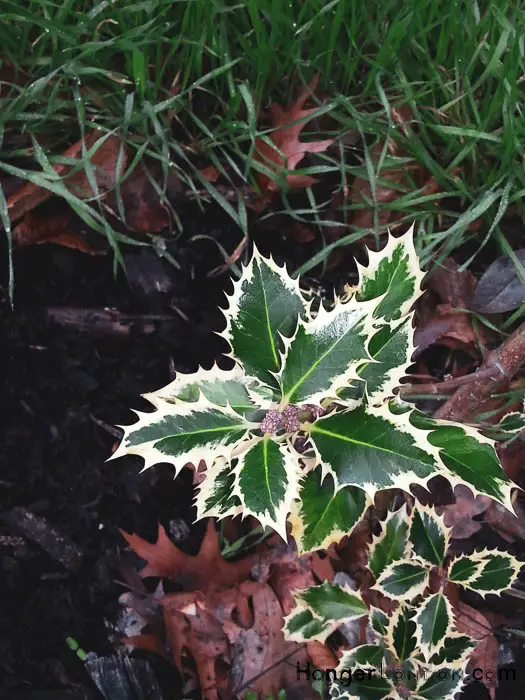
“Ferox Argentia” Silver Hedgehog Holly
Ferox Argentia, commonly known as Silver Hedgehog Holly, is an evergreen shrub that belongs to the Aquifoliaceae family. This plant is a hybrid cultivar of Ilex aquifolium and Ilex rugosa, and it is known for its compact, rounded habit and spiky, dark green foliage. The leaves of Ferox Argentia are glossy and leathery, with a silver-white margin that gives the plant a striking appearance. The silver-white margin becomes more pronounced as the plant matures, adding to its beauty.
Ferox Argentia is a hardy plant that can thrive in full sun to partial shade, and it is tolerant of a wide range of soil types. It is an excellent choice for hedging, as it forms a dense, impenetrable barrier that provides excellent privacy and security. In addition, the plant produces small, white flowers in spring, which are followed by red berries in autumn. These berries are a valuable source of food for birds during the winter months, making Ferox Argentia a valuable addition to any garden.
Overall, Ferox Argentia is a stunning, low-maintenance shrub that can bring year-round beauty to any landscape. Its striking foliage and hardiness make it an excellent choice for hedges, borders, and mass plantings. Whether planted as a standalone specimen or as part of a larger design, Ferox Argentia is sure to add interest and beauty to any garden or landscape.
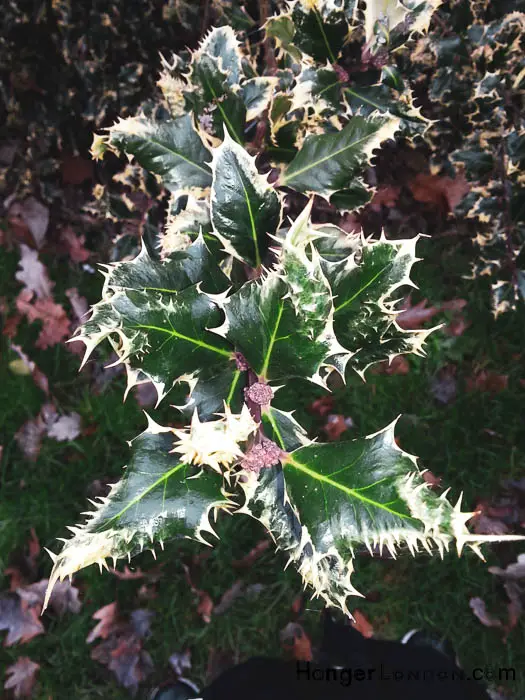
” Silver Queen”
Ferox Argentia, commonly known as Silver Hedgehog Holly, is an evergreen shrub that belongs to the Aquifoliaceae family. This plant is a hybrid cultivar of Ilex aquifolium and Ilex rugosa, and it is known for its compact, rounded habit and spiky, dark green foliage. The leaves of Ferox Argentia are glossy and leathery, with a silver-white margin that gives the plant a striking appearance. The silver-white margin becomes more pronounced as the plant matures, adding to its beauty.
Ferox Argentia is a hardy plant that can thrive in full sun to partial shade, and it is tolerant of a wide range of soil types. It is an excellent choice for hedging, as it forms a dense, impenetrable barrier that provides excellent privacy and security. In addition, the plant produces small, white flowers in spring, which are followed by red berries in autumn. These berries are a valuable source of food for birds during the winter months, making Ferox Argentia a valuable addition to any garden.
Overall, Ferox Argentia is a stunning, low-maintenance shrub that can bring year-round beauty to any landscape. Its striking foliage and hardiness make it an excellent choice for hedges, borders, and mass plantings. Whether planted as a standalone specimen or as part of a larger design, Ferox Argentia is sure to add interest and beauty to any garden or landscape.
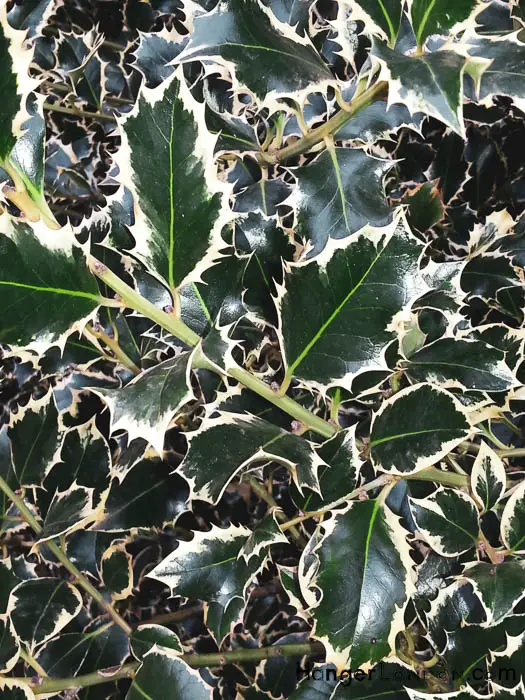
“Silver Lining”
Silver Lining Holly (Ilex x meserveae ‘Silver Lining’) is a cultivar of the Meserve holly, a hybrid between Ilex aquifolium and Ilex rugosa. This evergreen shrub grows to be around 8-10 feet tall and 6-8 feet wide, making it a great choice for hedges, screens, or specimen plants. The foliage is shiny, deep green with a silver-white margin, giving it a striking appearance that adds a touch of elegance to any garden.
This holly cultivar is known for its hardiness, as it is able to withstand temperatures as low as -20°F (-29°C) once established. It also tolerates a wide range of soil types, from sandy to heavy clay soils. Silver Lining Holly is also known for its resistance to deer browsing and salt spray, making it a great choice for coastal regions.
In addition to its attractive foliage, Silver Lining Holly produces small white flowers in the spring, which give way to bright red berries in the fall. The berries persist throughout the winter, providing a source of food for birds during the colder months. Overall, Silver Lining Holly is a great choice for gardeners looking for an easy-to-grow, attractive, and hardy evergreen shrub.
Ilex pedunculosa
Ilex pedunculosa, commonly known as Long-stalked Holly, is a species of holly native to China, Japan, and Korea. It is an evergreen shrub or small tree that can reach up to 20 feet tall with a spread of up to 10 feet. The leaves are glossy and dark green, with toothed edges and a spiny tip. The bark is gray and smooth, becoming rough and scaly with age. The flowers are small, and white, and appear in late spring to early summer. The fruit is a bright red berry that ripens in the fall and persists through winter.
Long-stalked Holly is a popular ornamental plant in gardens and parks due to its attractive foliage, showy fruit, and adaptability to a range of soil conditions. It prefers moist, well-drained soil and partial shade, but can tolerate full sun and dry conditions once established. It is also tolerant of pollution and salt spray, making it a good choice for coastal gardens. Long-stalked Holly can be grown as a specimen plant, hedge, or trained into a small tree. It is generally pest and disease resistant, but can be susceptible to leaf spot and holly leaf blight in wet conditions.
In traditional Chinese medicine, the leaves of Long-stalked Holly are used to treat fever, rheumatism, and skin diseases. The bark is also used as a diuretic and tonic. The bright red berries are toxic to humans but are a valuable food source for birds, who help to spread the seeds. Long-stalked Holly has been used in Chinese gardens for centuries and is valued for its symbolic significance. In Chinese culture, holly represents good fortune and protection, and is often used in festive decorations during the winter season.
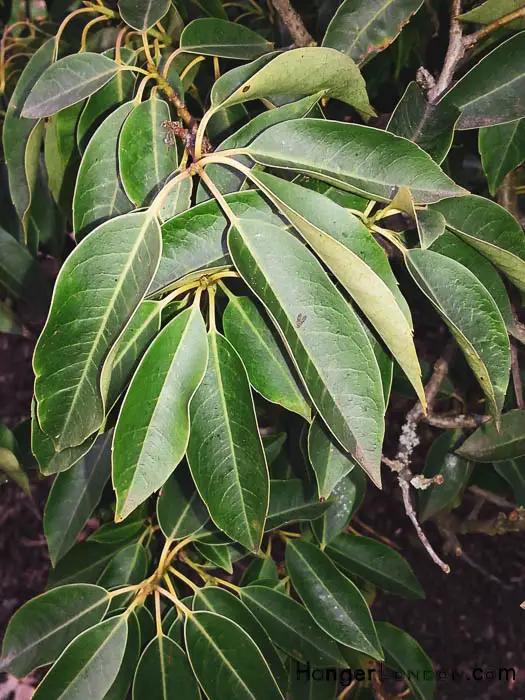
‘Argentea Pendula’
Argentea Pendula, also known as Silver Weeping Holly, is a beautiful and unique cultivar of the Ilex family. This holly is characterized by its weeping habit, and its slender, cascading branches. The leaves are dark green and glossy, with a silvery-white edge that gives it a striking contrast. In the winter, this holly produces red berries that provide a beautiful contrast to the silvery foliage.
This holly is a great choice for a specimen tree, as it can be trained to grow in a number of different shapes and sizes. It can also be used as an accent tree in a garden or as a focal point in a mixed border. It thrives in full sun to partial shade and is hardy in USDA zones 6-9. It is a relatively slow-growing tree, reaching a height of 15-20 feet at maturity, with a spread of 10-15 feet. The Silver Weeping Holly is also resistant to pests and diseases, making it a low-maintenance choice for any landscape.
‘Perry’s Weeping’
Perry’s Weeping Holly, also known as Ilex aquifolium ‘Pendula’, is an attractive and unique variety of holly trees. As its name suggests, this holly tree has a weeping habit, with branches that cascade down to the ground. Its dark green leaves are glossy and have a wavy margin, and they are tinged with bronze when they first emerge. Perry’s Weeping Holly is dioecious, which means it has separate male and female plants, and the female plants produce bright red berries in the fall and winter.
Perry’s Weeping Holly is a slow-growing tree that can reach a height of 15 to 20 feet (4.5 to 6 meters) over time. It prefers slightly acidic soil and partial shade to full sun exposure. This holly tree is relatively low-maintenance and is resistant to pests and diseases. It is an excellent choice for a focal point in a garden or as a specimen tree. Perry’s Weeping Holly can also be trained into an espalier against a wall or fence, which can add an interesting architectural element to a garden.
One of the benefits of Perry’s Weeping Holly is its ability to provide year-round interest in a garden. Its evergreen foliage provides a beautiful backdrop to other plants and flowers, and the bright red berries add a pop of color in the fall and winter months. Additionally, the weeping habit of this holly tree can create a sense of movement and flow in a garden, adding a dynamic element to the landscape. Whether used as a specimen tree or as part of a larger planting scheme, Perry’s Weeping Holly is a unique and attractive addition to any garden.
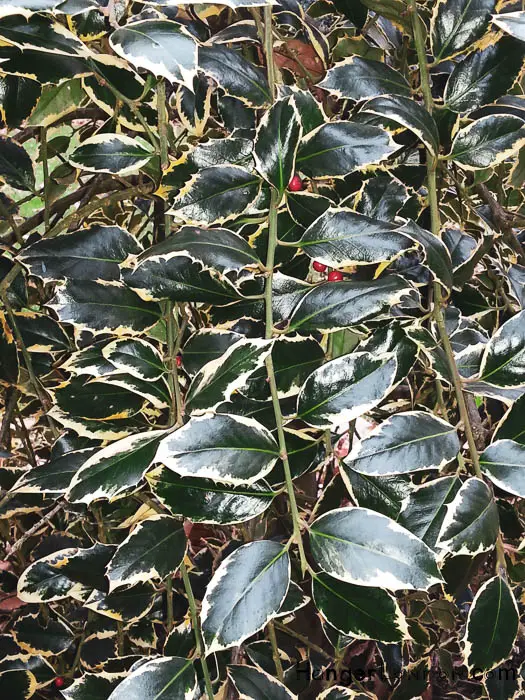
“Gold Flash”
Golf Flash Holly, also known as Ilex x altaclerensis ‘Golf Flash’, is a hybrid holly cultivar that was developed in the United Kingdom. It is a popular ornamental plant for gardens and landscapes due to its attractive foliage and winter berries. The plant is a cross between two holly species, namely, English holly (Ilex aquifolium) and Chinese holly (Ilex cornuta).
Golf Flash Holly is a slow-growing evergreen shrub that can reach a height of 6-8 feet and a width of 4-6 feet at maturity. The plant has glossy, dark green leaves that are slightly twisted and have spiny edges. The foliage has a distinctive variegation of bright yellow edges that gradually turn creamy white, providing an eye-catching contrast with the dark green of the leaves. During winter, the plant produces bright red berries that persist throughout the season, adding color to the garden.
Golf Flash Holly is a low maintenance plant that thrives in well-drained soil and prefers partial to full sun exposure. It is tolerant of drought and salt spray, making it an ideal choice for seaside gardens. The plant is also deer-resistant, making it a popular option for gardens located in areas with high deer populations. Golf Flash Holly is often used as a hedge, border, or accent plant in garden designs due to its attractive foliage and colorful berries.
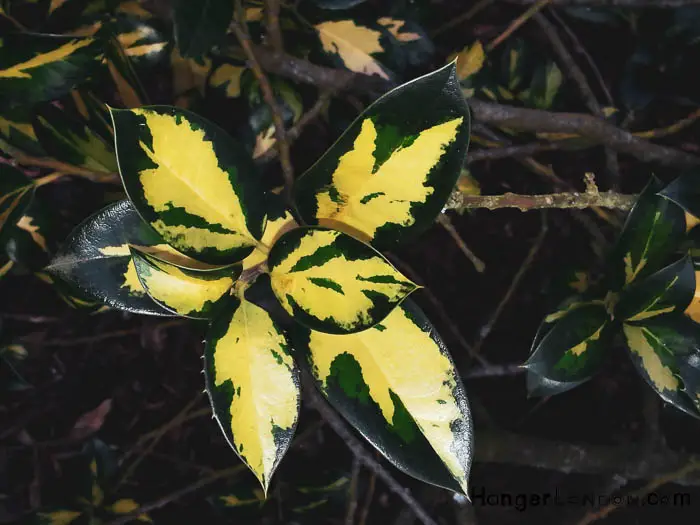
“Silver Milkboy Holly”
Silver Milkboy holly, also known as Ilex x meserveae ‘MonHye’, is a broadleaf evergreen shrub that belongs to the holly family Aquifoliaceae. It is a popular cultivar that features small, glossy, dark green leaves with a distinctive silver-white margin. The leaves are typically spiny and oval-shaped, measuring around 2-3 inches long and 1-2 inches wide. The plant produces small, white flowers in the spring, which are followed by bright red berries that persist through the winter, providing a great food source for birds.
Silver Milkboy holly is a slow-growing shrub that can reach a mature height of up to 8-10 feet and a spread of 6-8 feet. It is ideal for hedges, borders, or as a specimen plant in the garden. It prefers full sun to partial shade and well-drained, acidic soil. The plant is generally low maintenance and is relatively tolerant of drought, heat, and cold temperatures, making it a great option for gardeners in a variety of climates.
Silver Milkboy holly has gained popularity among gardeners for its striking foliage and attractive berries, making it a great choice for adding color and texture to the landscape. It is also known for its pest and disease resistance, making it a low-maintenance and reliable choice for gardeners of all levels of experience. Overall, Silver Milkboy holly is a beautiful and versatile evergreen shrub that is sure to make a stunning addition to any garden.
‘Aurea Regina’ Golden Queen Holly
Ilex aquifolium ‘Aurea Regina’, also known as Golden Queen Holly, is a compact, slow-growing evergreen shrub that can reach up to 2-3 meters in height and spread up to 1-2 meters in width. It is known for its glossy, variegated golden-yellow leaves, which contrast beautifully with its striking red berries that appear in autumn and winter. The leaves are spiny, ovate, and have a wavy margin, making it a great plant for providing texture and visual interest in the garden. This holly is a female cultivar, and it requires a male pollinator to produce berries.
‘Aurea Regina’ is a hardy holly that can thrive in full sun or partial shade, and it prefers well-drained soils that are slightly acidic. It is a versatile plant that can be used as a specimen plant or in mass plantings, and it is also suitable for hedges and topiary. It requires little maintenance, and pruning is only necessary to shape the plant or to remove any dead or damaged branches. Golden Queen Holly is also deer-resistant, making it a good choice for gardens where deer are a problem.
In addition to its ornamental value, ‘Aurea Regina’ has several medicinal properties. The leaves and bark have been used in traditional medicine to treat a variety of ailments, including fever, coughs, and arthritis. The berries are also said to have diuretic and laxative properties. However, it should be noted that the plant is toxic if ingested in large quantities and can cause vomiting, diarrhea, and other symptoms. As with any medicinal plant, it is important to consult with a healthcare professional before using it for medicinal purposes.
Peramidalis Holly
Ilex aquifolium ‘Pyramidalis’, commonly known as Pyramidalis Holly, is a slow-growing evergreen shrub with a narrow, columnar growth habit. It typically grows up to 20 feet tall and 8 feet wide, making it a good choice for vertical accent, screening, or as a background plant in a garden. Its narrow and dense form makes it an excellent hedge plant.
The glossy, dark green leaves are spine-tipped, leathery, and ovate, and measure about 2-3 inches long. In the winter, the plant produces clusters of small, inconspicuous, greenish-white flowers that are followed by red berries. The fruits persist through the winter and can attract birds to the garden. The bark of Pyramidalis Holly is gray to black and slightly rough.
Pyramidalis Holly is a low-maintenance shrub that prefers well-drained soil and partial to full sun exposure. It is tolerant of pollution, drought, and salt spray, making it a good choice for urban or coastal areas
Silver Van Tol Holly
Silver Van Tol holly (Ilex x attenuata ‘Silver Van Tol’) is an evergreen shrub or small tree that belongs to the holly family, Aquifoliaceae. It is a hybrid of two holly species, Ilex cassine and Ilex opaca, and was first developed in the United States in the 1950s. The plant is characterized by its attractive foliage, which has a glossy, dark green appearance and is edged with silver-white margins. The leaves are ovate, about 2-4 inches long, and have spiny teeth along their margins.
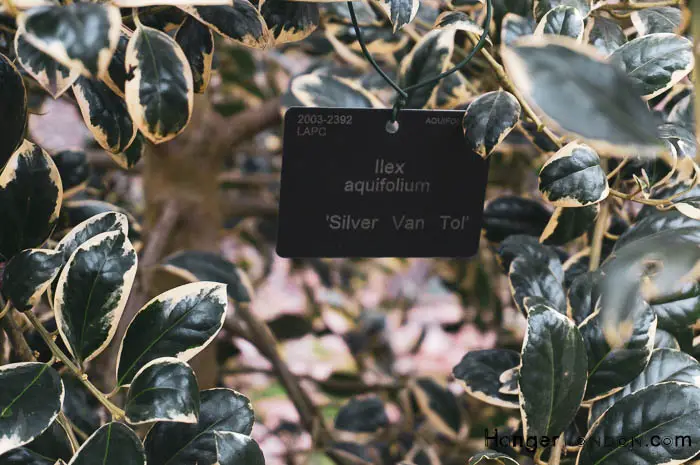
One of the key features of Silver Van Tol holly is its ability to thrive in a wide range of growing conditions. It is tolerant of heat, drought, and cold temperatures, making it a popular choice for gardeners in different parts of the world. The plant prefers well-drained soil but can also grow in wetter conditions. It is also relatively disease-resistant and low-maintenance, which makes it an attractive option for those who want a fuss-free plant.
The Silver Van Tol holly is a slow-growing plant that typically reaches a height of 10-15 feet and a spread of 6-8 feet when fully mature. It is a great option for hedges, screens, or as a specimen plant in the landscape. The plant produces small, inconspicuous white flowers in the spring, which are followed by red berries in the fall. The berries are an important food source for birds during the winter months, which makes the Silver Van Tol holly an excellent choice for wildlife gardens. Overall, the Silver Van Tol holly is a versatile and attractive plant that is well-suited for a range of garden settings.
Secluded Mediterranean Garden at Kew
This Garden was born around 2007 to study and exhibit natural plants from the Mediterranean Habitat. Cypress Trees, Tuscan olive trees, Stone Pine trees, Cork Oak trees, Cistus Lavender, and many more.
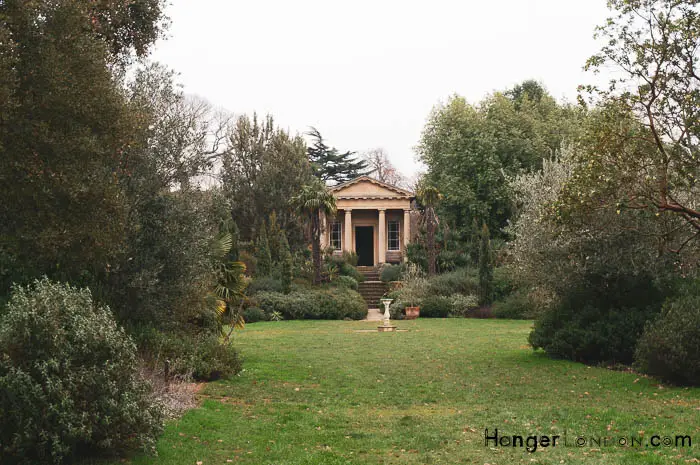
There is a very Romanesque-looking building with pillars, known as King William’s Temple which was a gift to Queen Victoria to commemorate William the IV and was built in 1837. Designed by Sir J Wyatville the architect of the IV. Inscriptions on the portico columns, give the dates of major battles the English fought and won, during the historic 1760-1815.
King Williams Temple at Kew
King William’s Temple is a prominent landmark situated in the Royal Botanic Gardens in Kew, London. It was built in 1837 in memory of King William IV, who reigned from 1830 to 1837. The temple was designed by Sir Jeffry Wyatville, who was a prominent architect of the time and was responsible for designing many buildings at Windsor Castle.
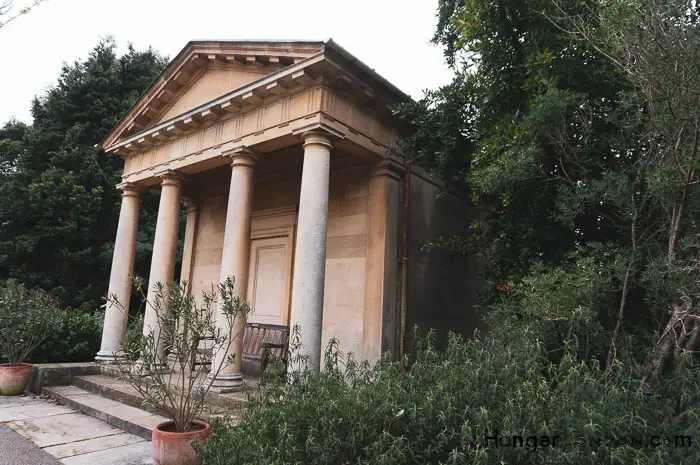
The temple is built in the Greek Revival style and is a small circular structure with a dome supported by eight columns. The columns are made of Portland stone, and the dome is made of lead. The temple’s design is inspired by the Temple of Vesta in Rome, which was a circular temple dedicated to the goddess of the hearth.
The interior of the temple is simple, with a plain white plaster finish and a small altar in the center. The altar is made of Carrara marble and has a Greek inscription on it, which reads “To the memory of King William IV, this temple is dedicated by his grateful subjects.” The temple’s design and location within the Royal Botanic Gardens make it a popular destination for visitors, who can enjoy its peaceful and tranquil surroundings.
In addition to its architectural significance, King William’s Temple has also played a role in scientific research. In the early 20th century, the temple was used as a laboratory for plant physiology research, and it was here that the botanist F.F. Blackman conducted experiments on the respiration of plants. Today, the temple remains an important part of the Royal Botanic Gardens and serves as a testament to the rich cultural and scientific history of the area.
The Mediterranean in the Winter
The Mediterranean biome is home to a rich variety of plant species that have adapted to the hot, dry summers and mild, wet winters of the region. At the Royal Botanic Gardens in Kew, London, there is a dedicated section that showcases the plants of the Mediterranean.
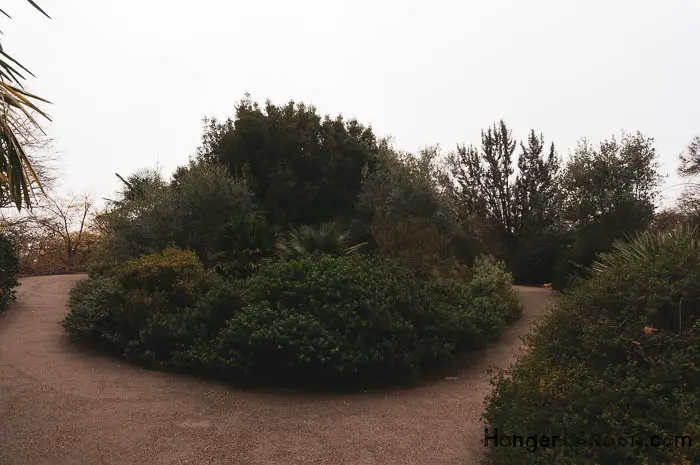
One of the most striking features of this section is the extensive collection of herbs and spices. Visitors can see and smell the aromatic plants that are commonly used in Mediterranean cuisines, such as basil, rosemary, thyme, and oregano. These plants are not only delicious but also have medicinal properties and have been used for centuries for their healing benefits.
Another highlight of the Mediterranean section is the impressive collection of succulent plants, including cacti, agaves, and aloes. These plants have thick, fleshy leaves and stems that allow them to store water during the long, dry summer months. They come in a range of shapes and sizes, from small, spiky rosettes to tall, tree-like forms.
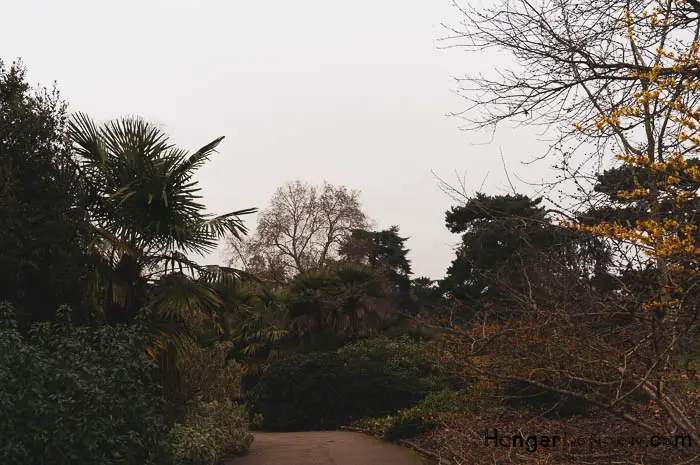
The Mediterranean biome is also home to a diverse range of shrubs and trees, including olive trees, citrus trees, and pines. These plants have been cultivated for centuries for their fruit, wood, and essential oils. The gnarled trunks of the olive trees and the sweet scent of the citrus blossoms create a unique and memorable experience for visitors to the Mediterranean section at Kew.
At the moment the Hamamelis tree, Commonly known as Witch Hazel is in bloom there. Which we feature below.
Witch Hazel Hamamelis shines bright in the winter sky
Witch hazel, also known by its scientific name Hamamelis, is a flowering shrub native to North America and Asia. One of the most notable features of witch hazel is its ability to bloom during the winter months, when most other plants are dormant. This makes it a popular choice for gardens and landscapes, as it adds a welcome splash of color to the drab winter landscape.
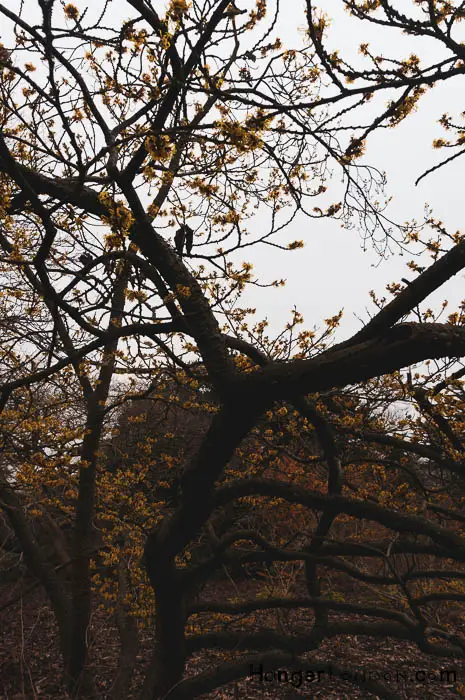
Witch hazel typically blooms from December through February, producing fragrant, spidery flowers in shades of yellow, orange, and red. The flowers are arranged in clusters along the branches of the shrub and are often described as looking like tiny fireworks. In addition to their beauty, the flowers are also of great value to pollinators such as bees, which are active even in the winter months.
Witch hazel is a hardy and adaptable plant that can thrive in a variety of growing conditions. It prefers well-draining soil and partial shade, but can also tolerate full sun and a range of soil types. As it matures, witch hazel can reach heights of up to 20 feet, though it can also be pruned to maintain a smaller size.
In addition to its ornamental value, witch hazel has been used for centuries for its medicinal properties. The bark and leaves of the plant contain compounds that have been shown to have anti-inflammatory and astringent properties and are often used in herbal remedies for a range of ailments. Witch hazel is also commonly used in skin care products for its soothing and healing properties.
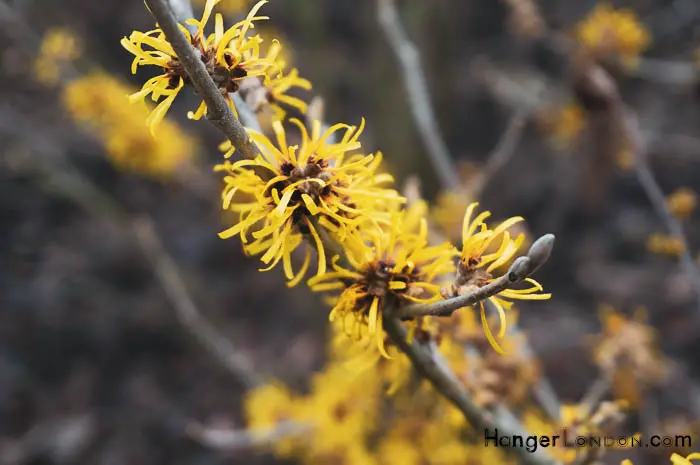
Part of Hamamelidaceae family. Deciduous shrubs with yellow, orange-red narrow petal flowers, the branches have no leaves. Ornamental trees, with a citrus type fragrance. The name stems from an old English Wiche Wice meaning “bendable”.
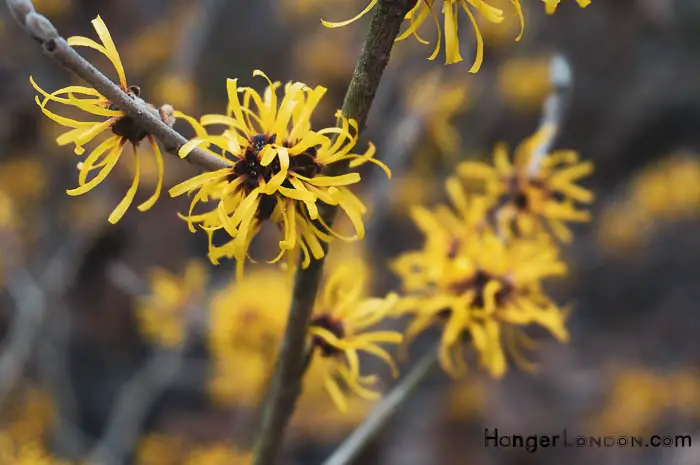
They use North American Hamamelis Virginiana for Astringent liquid used in skin and body preparations and herbalism. The parts used are the bark and its leaves. The properties flavonoids, tannins (hamamelitannin and proanthocyanidin). Thought to be good for anti-inflammatory, antiviral actions, and more recent studies confirming it has anti-radiation properties towards the sun and antioxidant properties. Many ancient and modern cultures have used Witch Hazel skin complaints and other health conditions.
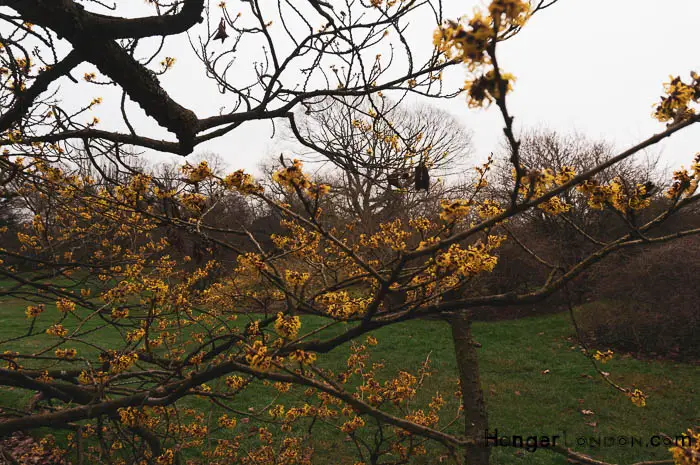
Hamamelis variation ” japonica is from Japan, whilst type Mollis is Chinese
Hamamelis, commonly known as witch hazel, is a genus of flowering shrubs native to North America and Asia. Within the genus Hamamelis, there are several different species and variations, including Hamamelis japonica and Hamamelis mollis. These two variations have distinct origins and characteristics, with Hamamelis japonica originating from Japan and Hamamelis mollis originating from China.
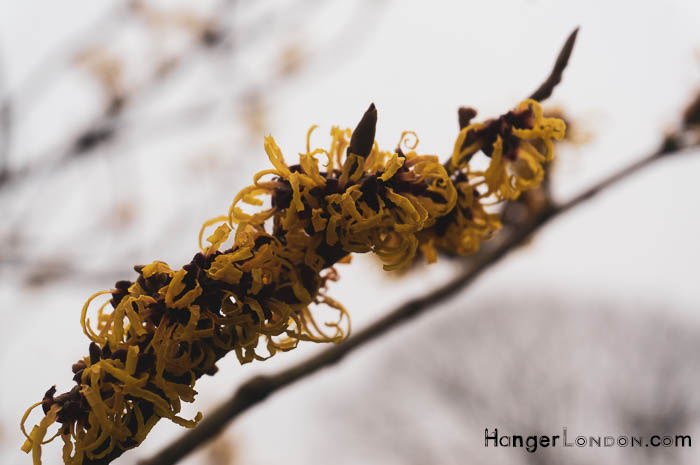
Hamamelis japonica is a deciduous shrub that can grow up to 15 feet tall. It is native to Japan and is known for its delicate, fragrant flowers that bloom in late winter or early spring. The flowers are small and yellow, and are arranged in clusters along the branches of the shrub. In addition to its ornamental value, Hamamelis japonica is also used in traditional Japanese medicine for its anti-inflammatory and analgesic properties.
Hamamelis mollis, on the other hand, is a deciduous shrub that can grow up to 20 feet tall. It is native to China and is known for its large, showy flowers that bloom in late winter or early spring. The flowers are typically shades of yellow, orange, or red, and are arranged in clusters along the branches of the shrub. Hamamelis mollis is also used in traditional Chinese medicine for its astringent and anti-inflammatory properties.
Despite their differences in origin and appearance, both Hamamelis japonica and Hamamelis mollis are prized by gardeners for their ornamental value and ability to bloom during the winter months. They are both hardy and adaptable plants that can tolerate a range of growing conditions and are often used in gardens and landscapes to add color and interest during the drab winter months.
This variety of Hamamelis has a Royal Horticultural Award
Hamamelis X Intermedia “Jelena”
Hamamelis X Intermedia “Jelena” is a hybrid variety of the Hamamelis genus that is a cross between Hamamelis mollis and Hamamelis japonica. This deciduous shrub can reach a height of up to 15 feet and a spread of up to 12 feet. It is known for its stunning coppery-orange flowers that bloom in late winter or early spring, which contrast beautifully against its dark green foliage. The flowers are fragrant and showy, with narrow petals arranged in a distinctive ribbon-like pattern.
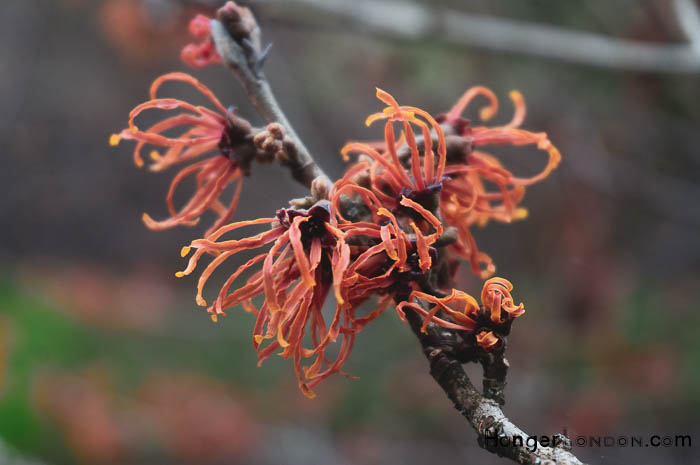
“Jelena” is a popular cultivar of Hamamelis X Intermedia due to its striking color and hardiness. It can tolerate a range of growing conditions, from full sun to partial shade, and is relatively low maintenance once established. The shrub prefers well-drained soil that is kept consistently moist, and benefits from regular pruning to maintain its shape.
In addition to its ornamental value, Hamamelis X Intermedia “Jelena” is also used in traditional medicine for its anti-inflammatory and astringent properties. The bark and leaves of the shrub contain compounds that have been shown to have therapeutic effects, particularly on the skin.
Overall, Hamamelis X Intermedia “Jelena” is a beautiful and versatile shrub that adds color and interest to gardens and landscapes during the winter months. Its unique coppery-orange flowers, combined with its hardiness and adaptability, make it a popular choice among gardeners and landscapers alike.
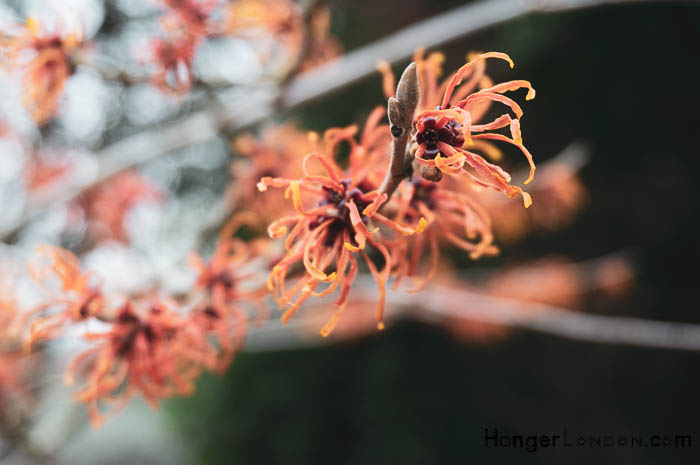
Hamamelis x intermedia ‘Orange Peel’
Hamamelis x intermedia ‘Orange Peel’ is a deciduous shrub that is a hybrid between Hamamelis mollis and Hamamelis japonica. It is known for its bright and showy flowers that appear in late winter or early spring, which have a distinct orange color and a sweet fragrance that can fill a garden. The flowers are made up of four strap-shaped petals that curl slightly inward, giving them a unique appearance.
‘Orange Peel’ can grow up to 12 feet tall and wide, making it a great choice for adding structure and color to a garden or landscape. It prefers well-drained soil that is kept moist but not waterlogged and can tolerate full sun to partial shade. In the fall, the leaves of ‘Orange Peel turn yellow, adding to its beauty.
In addition to its ornamental value, Hamamelis x intermedia ‘Orange Peel’ is also used in traditional medicine. The bark and leaves of the shrub contain compounds that have anti-inflammatory and astringent properties, making them useful in treating skin conditions and reducing swelling.
‘Orange Peel’ is a popular cultivar of Hamamelis x intermedia due to its unique color and fragrance. It is relatively low maintenance once established and can thrive in a range of growing conditions. It is a great choice for gardeners who want to add a pop of color to their garden during the winter months while also enjoying the potential medicinal benefits of the plant.
Temperate Greenhouse, Kew Gardens
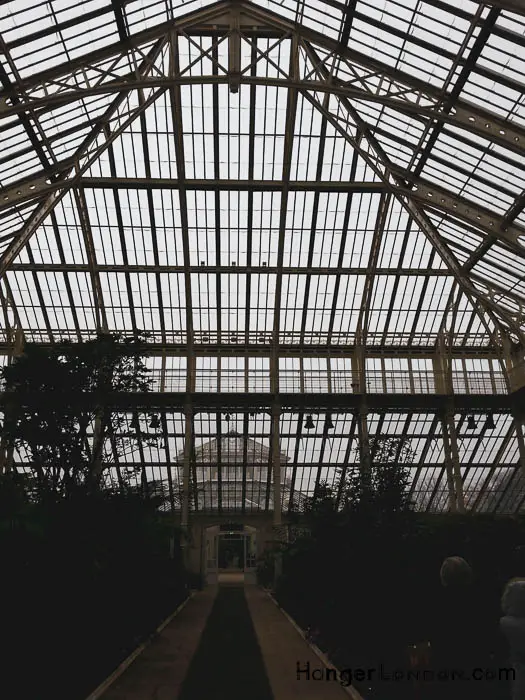
The Temperate Greenhouse at Kew Gardens is a stunning glass structure that houses an array of plant species from around the world. Located in the Princess of Wales Conservatory, the Temperate Greenhouse spans over 4,880 square feet and provides a controlled environment that mimics the moderate climates found in regions such as southern Africa, South America, and the Mediterranean.
Within the Temperate Greenhouse, visitors can explore a diverse collection of plant species, including cycads, ferns, succulents, and orchids. One of the most impressive exhibits is the South African display, which showcases a variety of fynbos plants that are endemic to the Cape Floristic Region, one of the world’s biodiversity hotspots.
In addition to its botanical wonders, the Temperate Greenhouse also features a range of architectural and design features that enhance the visitor experience. The glass walls and ceilings of the greenhouse allow natural light to flood in, while strategically placed pathways and seating areas encourage visitors to explore and engage with the plants.
Jasminum – Jasmine fragrant
Jasminum, commonly known as Jasmine, is a genus of flowering plants in the Oleaceae family. Known for their sweet, intoxicating fragrance, jasmine plants are prized by gardeners and perfumers alike. Jasmine flowers are usually white or yellow, and can be either single or double-petaled, depending on the species.
Jasmine flowers are highly fragrant, and their essential oils are often used in perfumes, soaps, and other cosmetic products. The flowers are also used in traditional medicine, where they are believed to have a variety of health benefits, including reducing stress, aiding in digestion, and improving sleep quality.
Jasmine plants are relatively easy to care for and can be grown in a variety of conditions, depending on the species. They prefer well-drained soil and full sun to partial shade, and can be grown as both climbing vines or shrubs. Some species of jasmine, such as Jasminum polyanthum, can even be grown indoors as houseplants.
Beautifully scented, delicate flower. Part of the Oleaceae botanical family the same as olives. The name is thought to derive from Persian “Yasameen”, “Gift from God”. The Plant can be an evergreen or where the leaves will fall deciduous.
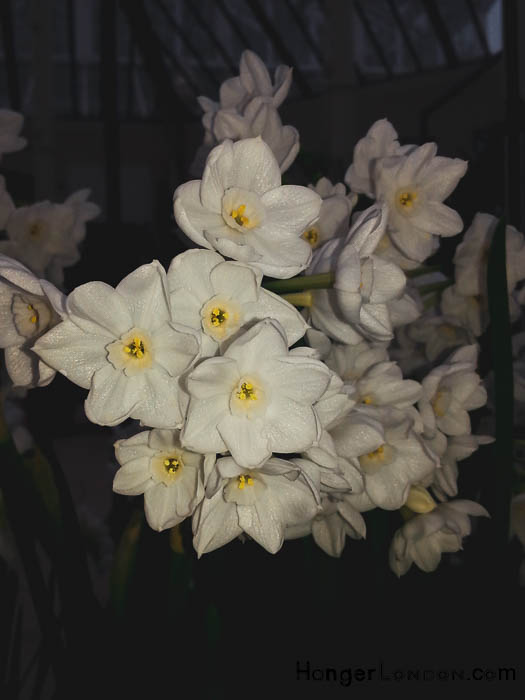
Yuletide Camellia
The Yuletide Camellia, also known as Camellia sasanqua ‘Yuletide’, is a beautiful flowering shrub that is highly prized for its stunning blooms that appear in the winter months. Its bright red flowers, which resemble small roses, add a pop of color to gardens during the holiday season when most other plants are dormant.
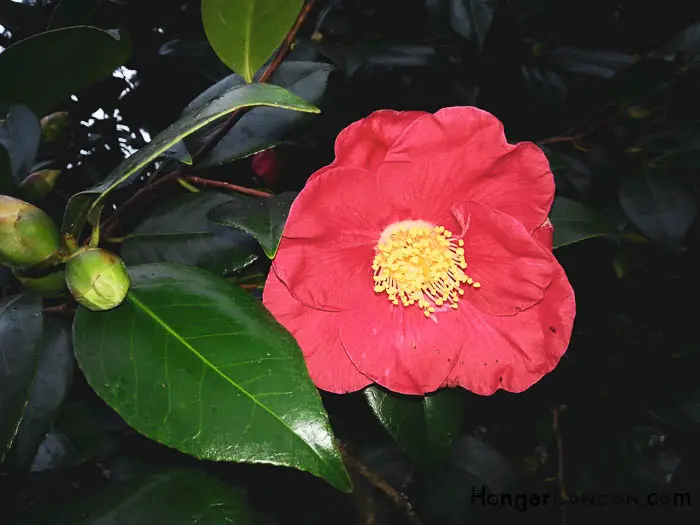
The Yuletide Camellia is a relatively low-maintenance shrub that prefers well-drained soil and partial shade. It can grow up to 10 feet tall and wide, making it a great choice for hedges or screens. In addition to its ornamental value, the Yuletide Camellia is also an important food source for bees and other pollinators during the winter months when food sources are scarce.
Overall, the Yuletide Camellia is a beautiful and versatile plant that adds a festive touch to any garden or outdoor space. Its hardiness and ease of care make it a popular choice for gardeners looking to add winter color and interest to their landscapes.




